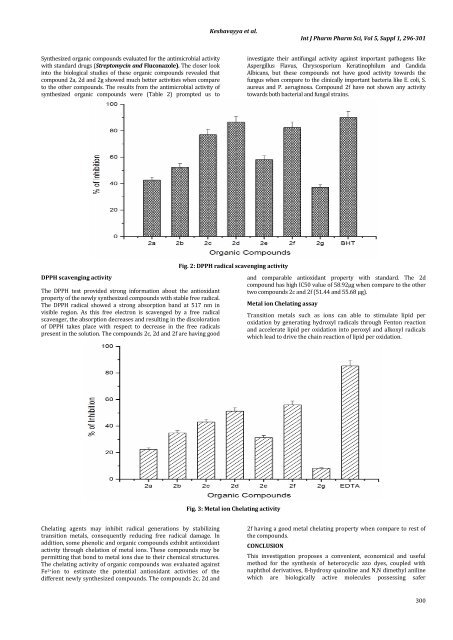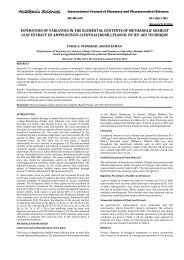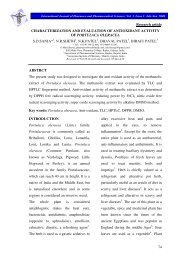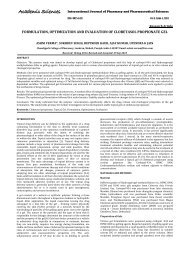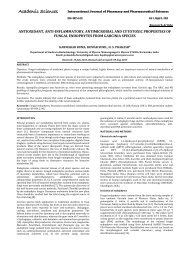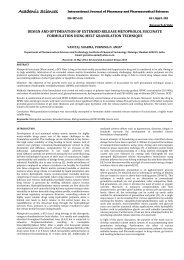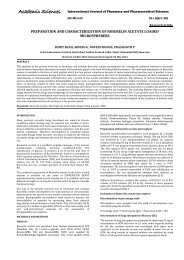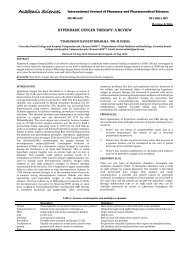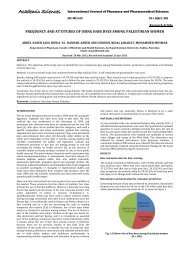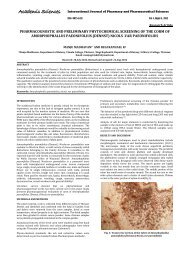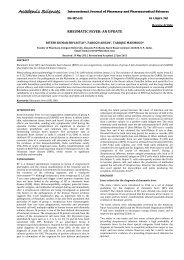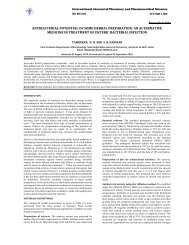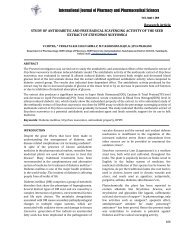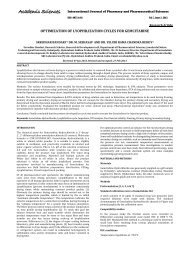synthesis, characterization and biological activity of heterocyclic azo
synthesis, characterization and biological activity of heterocyclic azo
synthesis, characterization and biological activity of heterocyclic azo
Create successful ePaper yourself
Turn your PDF publications into a flip-book with our unique Google optimized e-Paper software.
Synthesized organic compounds evaluated for the antimicrobial <strong>activity</strong><br />
with st<strong>and</strong>ard drugs (Streptomycin <strong>and</strong> Flucon<strong>azo</strong>le). The closer look<br />
into the <strong>biological</strong> studies <strong>of</strong> these organic compounds revealed that<br />
compound 2a, 2d <strong>and</strong> 2g showed much better activities when compare<br />
to the other compounds. The results from the antimicrobial <strong>activity</strong> <strong>of</strong><br />
synthesized organic compounds were (Table 2) prompted us to<br />
DPPH scavenging <strong>activity</strong><br />
The DPPH test provided strong information about the antioxidant<br />
property <strong>of</strong> the newly synthesized compounds with stable free radical.<br />
The DPPH radical showed a strong absorption b<strong>and</strong> at 517 nm in<br />
visible region. As this free electron is scavenged by a free radical<br />
scavenger, the absorption decreases <strong>and</strong> resulting in the discoloration<br />
<strong>of</strong> DPPH takes place with respect to decrease in the free radicals<br />
present in the solution. The compounds 2c, 2d <strong>and</strong> 2f are having good<br />
Chelating agents may inhibit radical generations by stabilizing<br />
transition metals, consequently reducing free radical damage. In<br />
addition, some phenolic <strong>and</strong> organic compounds exhibit antioxidant<br />
<strong>activity</strong> through chelation <strong>of</strong> metal ions. These compounds may be<br />
permitting that bond to metal ions due to their chemical structures.<br />
The chelating <strong>activity</strong> <strong>of</strong> organic compounds was evaluated against<br />
Fe 2+ ion to estimate the potential antioxidant activities <strong>of</strong> the<br />
different newly synthesized compounds. The compounds 2c, 2d <strong>and</strong><br />
Keshavayya et al.<br />
Fig. 2: DPPH radical scavenging <strong>activity</strong><br />
Fig. 3: Metal ion Chelating <strong>activity</strong><br />
Int J Pharm Pharm Sci, Vol 5, Suppl 1, 296-301<br />
investigate their antifungal <strong>activity</strong> against important pathogens like<br />
Aspergillus Flavus, Chrysosporium Keratinophilum <strong>and</strong> C<strong>and</strong>ida<br />
Albicans, but these compounds not have good <strong>activity</strong> towards the<br />
fungus when compare to the clinically important bacteria like E. coli, S.<br />
aureus <strong>and</strong> P. aeruginosa. Compound 2f have not shown any <strong>activity</strong><br />
towards both bacterial <strong>and</strong> fungal strains.<br />
<strong>and</strong> comparable antioxidant property with st<strong>and</strong>ard. The 2d<br />
compound has high IC50 value <strong>of</strong> 58.92µg when compare to the other<br />
two compounds 2c <strong>and</strong> 2f (51.44 <strong>and</strong> 55.68 µg).<br />
Metal ion Chelating assay<br />
Transition metals such as ions can able to stimulate lipid per<br />
oxidation by generating hydroxyl radicals through Fenton reaction<br />
<strong>and</strong> accelerate lipid per oxidation into peroxyl <strong>and</strong> alkoxyl radicals<br />
which lead to drive the chain reaction <strong>of</strong> lipid per oxidation.<br />
2f having a good metal chelating property when compare to rest <strong>of</strong><br />
the compounds.<br />
CONCLUSION<br />
This investigation proposes a convenient, economical <strong>and</strong> useful<br />
method for the <strong>synthesis</strong> <strong>of</strong> <strong>heterocyclic</strong> <strong>azo</strong> dyes, coupled with<br />
naphthol derivatives, 8-hydroxy quinoline <strong>and</strong> N,N dimethyl aniline<br />
which are <strong>biological</strong>ly active molecules possessing safer<br />
300


